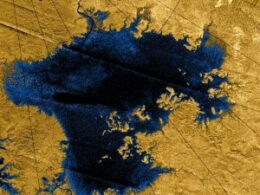Catastrophic cosmic crash created Comet 67P, new research shows
The peculiar duck shape of Comet 67P/Churyumov-Gerasimenko, revealed by ESA’s Rosetta space probe, was produced by the catastrophic collision of two icy bodies, according to new research.

Some previous comets that were closely observed by passing spacecraft have also displayed elongated or distorted shapes, as opposed to the “icy snowballs” that had once been expected by astronomers.
This suggests that collisions between frozen fragments in the Kuiper Belt beyond Neptune have been a common occurrence during the history of the Solar System.
The new research was made by an international team led by Patrick Michel of France’s National Center for Scientific Research (CNRS). It suggests that the cosmic collisions completely destroyed the original comets, but that their debris clumped together again.
This explanation apparently can explain some of the more enigmatic structures that were observed on Comet 67P by Rosetta during its long journey accompanying the celestial visitor through the Solar System.
Related: Rosetta’s comet is giving up secrets older than the Solar System
Related: Rosetta ends mission by landing on comet’s surface
It had been thought that such collisions between two icy bodies would have to have been at low speed since they were objects with very low density and moving slowly through space.
However the team’s simulations show that a more destructive impact could have produced Comet 67P. During a high-speed collision, only a small amount of material would be reduced to dust.
On the opposite sides of the impacting bodies, materials rich in volatile elements withstand the collision and are ejected at low enough speeds for them to be drawn back to each other and clump together again.
Surprisingly, the whole process takes only between hours and a few days, say the scientists, whose work is reported in the journal Nature Astronomy. But it explains how Comet 67P keeps its low density and abundance of volatile elements – chemical compounds such as water with low boiling points.
Team leader Michel is based at the laboratoire Lagrange (CNRS/Observatoire de la Côte d’Azur/Université de Nice-Sophia Antipolis).
Other comets imaged by spacecraft
Before the space age, our best views of comets were made with astronomical telescopes. They showed nothing more than a fuzzy blur with a star-like nucleus, plus tails of gas and dust for the brighter ones.
Comet 1P/Halley
A number of comets have now been photographed close up by spacecraft. The first to be visited, by a flotilla of international probes, was the best known, Halley’s Comet, in March 1986.
The European Space Agency’s Giotto space probe flew by at a distance of around 2000 km (1200 miles). Its close-up images showed the heart of the comet – 15km (9miles) long and called the nucleus – was not round but shaped like a peanut.
Comet 19P/Borrelly
In September 2001, a NASA technology demonstration spacecraft called Deep Space 1 flew by Comet Borrelly at a distance of 3417 km (more than 2000 miles). Its images showed the comet’s 8 km (5 mile) long nucleus was once again not round but more like a bowling pin.
Comet 81P/Wild
The first comet found to have a vaguely round nucleus, about 5 km (3 miles) wide, was Comet Wild 2, otherwise known as 81P/Wild. It was visited by NASA’s Stardust mission in January 2004.
Comet 9P/Tempel
Probably the most dramatic encounter was made with Comet 9P/Tempel, otherwise known as Tempel 1, by NASA’s Deep Impact spacecraft. It fired an impactor directly into the comet’s 7.6 km (4.7 mile) long nucleus on July 4, 2005, to see what lay beneath the surface. The impact blast was so bright however that it blinded the camera. Another NASA spacecraft later returned to the comet.
Comet 103P/Hartley
This comet, also known as Comet Hartley 2, was also imaged by NASA’s Deep Impact probe, on its new EPOXI mission, in November, 2010. It showed that the comet was another elongated, twin-lobed nucleus, which is only about 2.4 km ( 1.5 miles) long. Skymania reported on the flyby.
Related: NASA shortlists missions to return to Titan and Comet 67P
★ Keep up with space news and observing tips. Click here to sign up for alerts to our latest reports. No spam ever – we promise!

